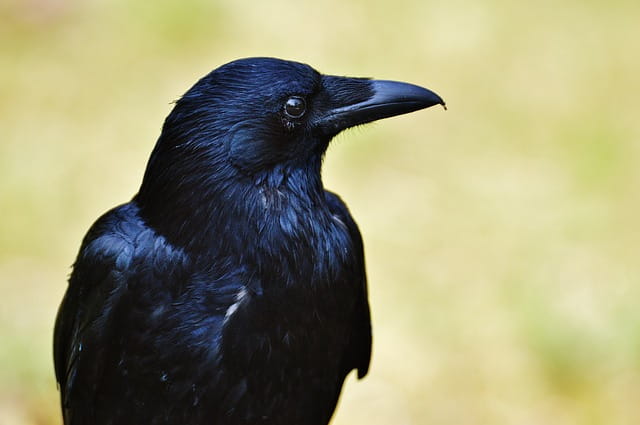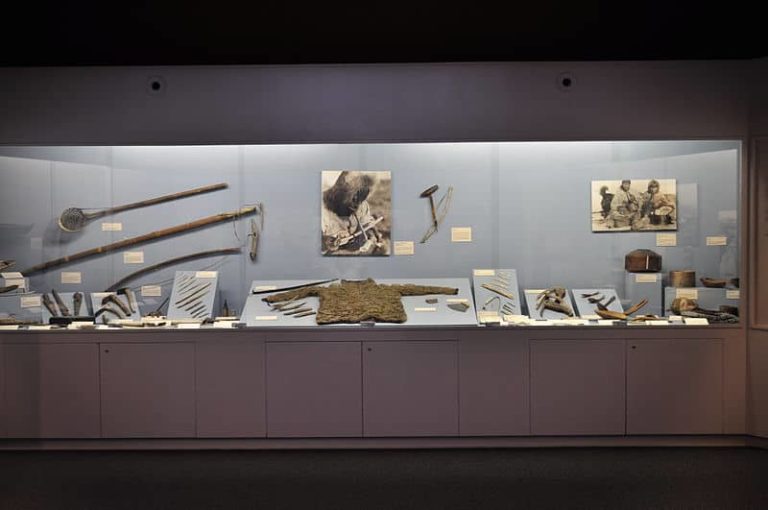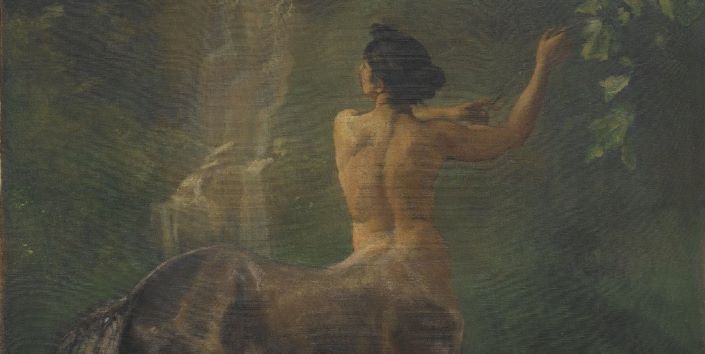The Powwow at the End of the World by Sherman Alexie
Sherman Alexie’s “The Powwow at the End of the World” is about how an enraged Native American speaker thinks of avenging the wrongs caused to their habitation, culture, and most importantly their lives. Alexie’s poetic persona visualizes the destruction of the Grand Coulee Dam. He reiterates the fact that he would forgive those who have toppled their lives after their grievances are redressed. The anger of his community does not allow him to forgive them easily. To summarize, through this piece, Alexie depicts how the Grand Coulee Dam, other dams located on the Columbia River, and nuclear reactors affected their way of living. Those things not only displaced them from their native land but also ransacked their indigenous culture. This poem appears in Alexie’s poetry collection, The Summer of Black Widows (1996).
- Read the full text of “The Powwow at the End of the World“
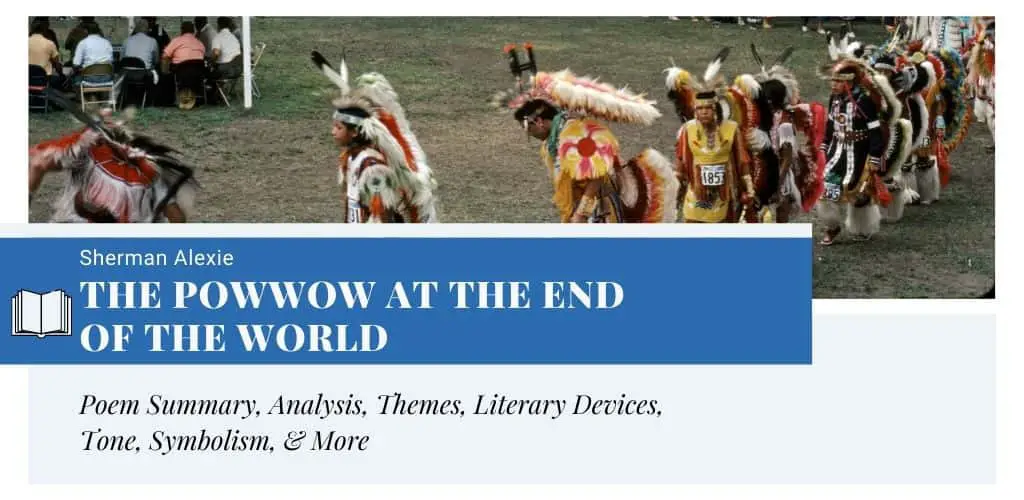
Summary
“The Powwow at the End of the World” presents a Native American speaker who imagines a dystopian picture. It concerns the destruction of the Grand Coulee Dam by a great flood.
He imagines how an Indian woman topples the dam merely using her shoulder. It makes the huge quantity of water stored inside the dam ceaselessly flow through the rivers. As a result, it floods the nearby area, breaking other dams and reactors of Hanford. The floodwater finds its way to the Columbia River and reaches its mouth where it meets the Pacific ocean.
A salmon is waiting there. It drinks the first drop of the floodwater and starts swimming all its way through the Columbia River. Finally, it reaches a secret reservoir where the speaker is waiting. The salmon leaps up in the night air. A thunderbolt originates from its body and burns the brush near his feet. The fire helps them to navigate through the destroyed land and find the huts of native Americans.
According to the speaker, the creature has three stories to tell. One of the stories will teach them how to pray. Another one will make them laugh. The last one will give them a reason to dance together.
By the end, the speaker says that at this moment the people from his tribe are going to hold a powwow. They will gather around that fire and dance. Only then, the speaker can only forgive those who made them suffer.
Meaning
The title of Alexie’s poem “The Powwow at the End of the World” sounds apocalyptic. Through the title, the poet refers to a dance ceremony or powwow of native Indians. It is a type of social gathering where they gather and dance by wearing traditional costumes.
But, in the title, the reference is made to a traditional dance that is held at the end of the world. What does the “end of the world” signify? The “end” of the world does not mean the real destruction of the world. Rather it is a reference to the destruction of the Grand Coulee Dam and other dams which uprooted them from their traditional course of living.
The rulers attacked the lives of indigenous tribes. They displaced them from their roots. That’s why, the speaker of this poem says that the natives would observe a powwow when the dams, reservoirs, and reactors are destroyed. Alexie metaphorically portrays it as the “end of the world”. It also signifies the end of all their sufferings.
Form, Rhyme Scheme, & Meter
“The Powwow at the End of the World” is written in free-verse as it does not contain a specific rhyme scheme or metrical pattern. It consists of 27 long lines. The lines are prosaic. The overall poem is told from the perspective of a first-person speaker. For this reason, it is an example of a lyric poem.
Alexie creates an internal rhyming by repeating the line “I am told by many of you that I must forgive and so I shall” at the beginning of each section. He repeats the line a number of times to emphasize what he wants to happen. The destruction of the dams can only satiate his anger. Alexie depicts this anger through this repetition. This repetition is also used to create an interconnection between his thoughts.
Regarding the meter, it does not contain any. Alexie uses both the iambic and trochaic meter with a few variations here and there. Besides, it seems that the first-person speaker converses directly with the people from his tribe. But, throughout the piece, they don’t utter a single word. For this reason, it can also be considered as an example of a dramatic monologue.
Literary Devices & Figurative Language
Let’s explore the important literary devices used in “The Powwow at the End of the World”.
Repetition
The first line of the poem “I am told by many of you that I must forgive and so I shall” is repeated throughout. It is meant for the sake of emphasis. Besides, this line sounds like a proclamation of a metaphorical war between the indigenous Americans and the rulers. Alexie also repeats the pronoun “I” a fair number of times for making the lines sound more authoritative.
Allusion
In this poem, there are several allusions.
- Firstly, Alexie alludes to the Grand Coulee Dam and its impact on native American’s culture.
- In the following section, there are allusions to similar dams and how they caused trouble in their lives.
- Last but not least, the reference to “powwow” hints at the traditional form, not the modern format of dancing in costumes.
Enjambment
It occurs throughout the poem. Alexie uses this device to maintain the flow and create an interconnection between the lines. For example, readers can find the use of enjambment in the following lines:
I am told by many of you that I must forgive and so I shall
after an Indian woman puts her shoulder to the Grand Coulee Dam
and topples it.
Alliteration
The repetition of similar sounds occurs in the following phrases:
- “dam / downriver”
- “floodwaters find”
- “swallowed by that salmon”
- “salmon swims”
- “upstream, until”
- “shallows of a secret bay”
- “lightning bolt at the brush,” etc.
Personification
The poet personifies the salmon fish and invests it with the idea of speaking. It occurs in this line:
after we Indians have gathered around the fire with that salmon
who has three stories it must tell before sunrise: one story will teach us
(…)
the third story will give us reason to dance.
Irony
The title “The Powwow at the End of the World” is ironic. It does not refer to the real destruction of the world. Rather, it refers to the end of all the suffering caused to the native Americans. For example, the Grand Coulee Dam made them leave their native habitation and harmed their course of living. Previously, they feed on the salmon they caught from the Columbia River. After the creation of the dam, salmon could not enter through the river for breeding. Apart from that, Alexie uses irony in the last lines of the poem:
of you that I must forgive and so I shall when I am dancing
with my tribe during the powwow at the end of the world.
Line-by-Line Analysis & Explanation
Lines 1-3
I am told by many of you that I must forgive …
… topples it.
Sherman Alexie’s poem “The Powwow at the End of the World” begins directly with the poetic persona claiming that he is told by many of “you”. He addresses the native American people of his tribe by the pronoun “you”. The angry tone of the speaker is visible from the very beginning. Besides, the repetition of the pronoun “I” sounds like an authoritarian speaker is expressing his stand regarding a matter.
He tells readers that he “must forgive” and reiterates the fact by saying “so I shall”. The repetition sounds a bit ironic. It seems the speaker is not going to forgive at any cost. That’s why he uses this way of speaking.
He refers to an Indian woman. She puts her shoulder to the Grand Coulee dam and interestingly topples it. Is it even possible? It is possible in hyperbolic language. To clarify, here the speaker is so angry that he thinks a native woman is as angry as him. She can easily topple the dam with her broad and powerful shoulder. This line also glorifies the physical strength of native Americans.
Grand Coulee Dam and its impact on Native Americans
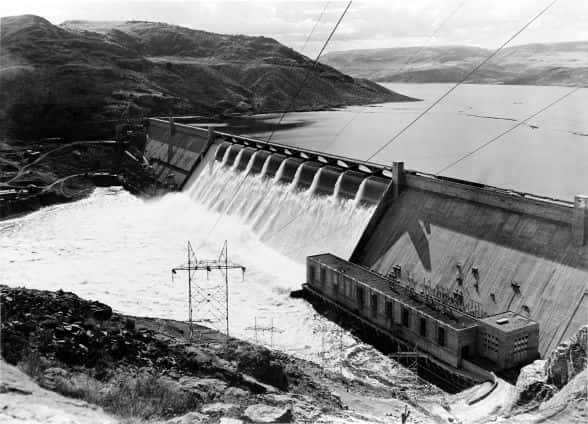
The Grand Coulee Dam is situated on the Columbia River. It was constructed between 1933 and 1942. The dam had severe consequences for the local Native American tribes. Their traditional way of living revolved around salmon and the habitat of that area. The dam flooded the habitation of Native Americans who had been living and hunting there for thousands of years. Thus the construction of the dam forced them to relocate their settlements and graveyards. Over 250 Colville Indians lived in the town of Inchelium, Washington. Their town was also submerged by the flood. The construction of the dam also had a negative impact on the wildlife and ecology of the area.
Now, the first few lines of “The Powwow at the End of the World” are making sense. The speaker is one of them who had lost their homes and land after the building of the dam. Nothing could compensate those who lived there and unfortunately had to relocate elsewhere. Though the Office of Indian Affairs tried to put forth the concerns of the tribes, it could not compensate for the loss and pain of the natives. The speaker’s anger also reflects this fact.
Lines 3-5
I am told by many of you …
… the Grand Coulee.
Readers can see that after finishing one idea, Alexie uses the same pattern of presenting a new idea. The line “I am told by many…” also hints at another idea. It reveals the tolerance of native Americans. They never opposed what others were doing to them. Still, everything has a limit. When the oppression reaches its optimum level, people like Sherman Alexie speak up. They rage against the wrongs with violent energy. Then society starts to question, “Why are they doing that?”
Whatsoever, in these lines, the speaker anticipates how the floodwater that once inundated their lands, is going to destroy each successive dam located on the Columbia River. Readers can find the use of consonance in “dams downriver”. Here, the hard “d” sound is repeated. It sounds like drum beats.
The “floodwater” acts as a symbol of their anger. It would burst all the dams that toppled their lives and detached them from their traditions.
Lines 5-10
… I am told by many …
… in the Pacific.
The following lines also begin similarly. Each line presents the happenings in succession. Firstly, the Grand Coulee Dam gets toppled down. As a result, the water stored inside the dam floods the area. In this section, the speaker details what happens afterward.
In the first line of this section, he describes how the floodwater flows through the Columbia River and reaches its mouth. A river’s mouth is a place where it merges into a bigger water body such as an ocean or sea. Like, the Columbia enters into Pacific ocean. According to the speaker, the floodwater will cause the water level of the pacific to rise.
The next line introduces the salmon. As mentioned earlier, the construction of the Grand Coulee Dam permanently blocked fish migration across the Columbia River. It removed over 1,770 kilometers of the natural spawning habitat of salmon. The destruction of the spawning grounds upstream from the dam prevented several tribes from holding the first salmon ceremony. In this way, the dam effectively ended the traditional course of living of the native inhabitants.
According to the speaker, the floodwater is swallowed by “that salmon” waiting in the Pacific for years. Why does the poet use “that salmon” instead of “the salmon”? It is because the poet is referring to the salmon that could not enter the Columbia River due to the construction of the dam. One of the ancestors of the salmon has been waiting to enter the river since the creation of the dam. It is as angry as the speaker. The floodwater makes it realize that now it can freely enter the river.
Lines 10-13
I am told by many of you …
… Hanford.
Thereafter, that salmon swims upstream like before. Through the mouth of the Columbia, it finds all its way through the flooded cities, broken dams, and abandoned nuclear reactors of Hanford. Why does the poet refer to the abandoned Hanford site? Let’s know more about the Hanford Site below:
Hanford Site
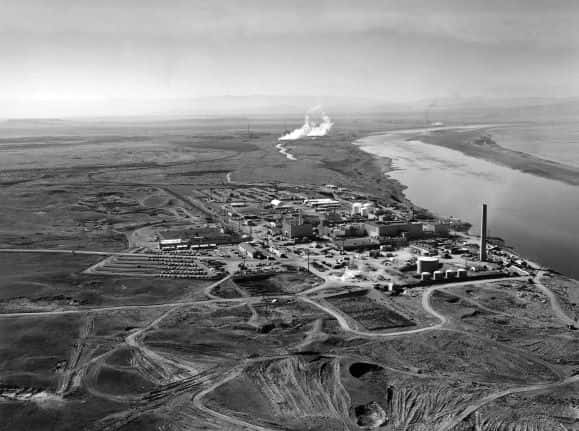
The US federal government operated a nuclear production site on the Columbia River. The site has been known by several names, including Hanford Project, Hanford Nuclear Reservation, etc.
It was established as part of the Manhattan Project in Hanford in 1943. Plutonium manufactured at the site was used in the first nuclear bomb and in Fat Man, the atomic bomb that destroyed Nagasaki, Japan, in World War II.
Government documents have confirmed that the operations held at Hanford released significant amounts of radioactive materials into the air as well as the Columbia River. At the end of the Cold War, the site was decommissioned. Most of the reactors were shut down between 1964 and 1971. Currently, the Hanford site is the most contaminated nuclear site in the US.
The confluence of the Yakima, Snake, and Columbia rivers has been a meeting place for native tribes for centuries. Native American habitations of this area date back over ten thousand years. They continued to live in the area until the 20th century. Later they were relocated from the site.
The nuclear waste contaminated the Columbia River. It also contaminated salmon spawning in the shallows near the Hanford site. Naturally, it impacted Native American communities who depended on the river for their customary diets.
Not only the Grand Coulee Dam hacked their lives but the nuclear weapon production site of Hanford severely caused damaged them. While the speaker thinks about it, it makes him extremely angry. He wishes the floodwater also washes the abandoned site away from his sight.
Lines 13-16
I am told by many of you …
… a secret bay on the reservation where I wait alone.
In these lines, the speaker describes how the salmon swims through the mouth of the Spokane River. Spokane is a tributary of Columbia. After entering into the main river (Columbia), the creature swims upstream until it arrives in the shallows of a secret bay on the reservation. The speaker waits there alone.
Shallow is an area of the sea, a lake, or a river where the water is not very deep. It is an ideal place for spawning. The salmon chooses this spot not to release its eggs but to converse with the speaker. Apart from that, the “secret bay” situated on the reservation can be a place where Native inhabitants held social meetings in secrecy.
The speaker waits for the salmon. It seems the creature has a message to deliver him. Whatsoever, in the following lines, Alexie describes what happened after the speaker meets that salmon.
Lines 17-23
… that salmon leaps into the night air above the water, …
… three stories it must tell before sunrise:
The poem is nearing its end. But, the tone of the speaker has not changed. He begins his sentence similarly as he has said earlier. The reason is that he is extremely agitated with the things that he and his people endured. He can only forgive after the end of all their tribulations.
In the first line of this section, he depicts the salmon leaping into the night air above the water. It throws a lightning bolt as if it has some supernatural abilities. This “lightning bolt” is a symbol of rage and anger.
The bolt from the salmon burns the brush near the speaker’s feet. “Brush” is an undergrowth of small trees and shrubs. The fire leads all of the lost Indians home. Those who lost their native habitation after the creation of the Grand Coulee Dam and nuclear reactors are rehabilitated. The fish, like a guide, leads them to their lost homes with the fire it produces with the lightning bolt.
Thereafter, the speaker proclaims by saying, “we Indians…” This phrase emphasizes their identity and their pride in being native Americans. They gather around the fire with the salmon to celebrate the first salmon ceremony again.
What is the first salmon ceremony?
Native Americans honored the first foods they caught or gathered in the spring. The first salmon ceremony is a celebration after the arrival of the salmon run.
The first salmon was ritually sliced and small pieces were distributed among the people. The carcass was returned to the water accompanied by ritualistic prayers. It ensured that the salmon would return the next year.
Alexie personifies the salmon and says that it has three stories to tell those who gathered around the fire. Everything is happening during the night and the creature has to finish the stories before sunrise. This line contains an anticipation of the approaching destruction of the world. So, there is an urgency in the speaker’s tone.
Lines 23-27
… one story will teach …
… during the powwow at the end of the world.
The salmon begins its stories. Each story has a moral at the end. Alexie does not introduce the stories in the poem but he refers to their morals. According to the speaker, the first story will teach them how to pray. Praying was an integral part of the indigenous culture. As they were uprooted from their basic essence, they forgot how they prayed. With time, the reason for prayer lost its importance. Therefore, the first salmon will teach them how to pray and the value of prayer.
The second story will make them laugh for hours. They had endured a lot. After all their struggles and tribulations, they are finally nearing a happy beginning. At this moment, they need to laugh, with all their hearts.
Through the third story, the salmon will give them a reason to dance. It is a reference to “powwow” that also lost its importance in modern times.
What is Powwow?
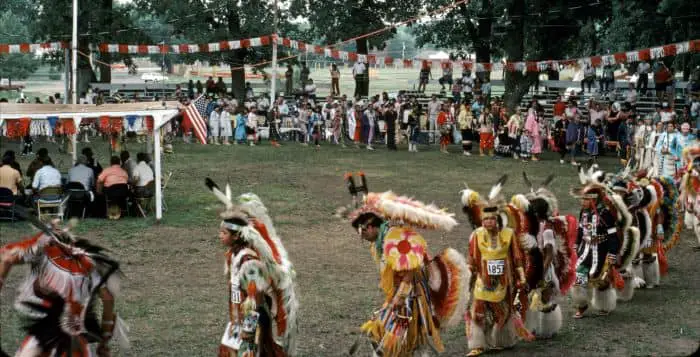
It is a celebration of American Indian culture in which people from diverse tribes gather for dancing, singing, and honoring the traditions of their ancestors. The term “powwow” derives from a curing ritual, originated in the Northeast Indians. In the Narragansett (an Algonquian American Indian tribe from Rhode Island), the term denotes “spiritual leader”.
In the last line of “The Powwow at the End of the World,” the speaker says when he can dance with his tribe during the powwow at the end of the world, he can forgive the destructors of their rich culture. The “end of the world” signifies the destruction of the dams and nuclear reactors. When the structures that were built on their native habitations are destroyed totally, the native people will hold a powwow celebrating their long battle against cultural imperialists.
Themes
In Sherman Alexie’s poem “The Powwow at the End of the World,” the themes of indigenous culture, identity, and suffering can be found. Let’s explore each of these themes.
Indigenous Culture
The theme of the indigenous culture of native Americans can be found in this poem. In this piece, Alexie refers to their traditional dance form powwow, the first salmon ceremony, and social gathering. Through each reference, the speaker celebrates their tradition. He describes how his people are going to celebrate again after the destruction of the Grand Coulee Dam and Hanford site. Alongside that, when the first salmon enters the Columbia River, it is also a happy moment for them. They can celebrate their ceremony again after a long time. Before the relocation, they held the ceremony each year.
Identity
The theme of identity is an integral part of the poem. Alexie’s speaker stands for the Native American tribes. He is the voice of the thousands of people who were forced to leave their land and cut from their natural course of living. He is agitated for all their sufferings. That’s why he is adamant about revenge. His tone never softens throughout the piece. Each time he reiterates the fact that he can only forgive them after the destruction of the dams and other structures built on their land.
There is an interesting thing to note regarding the language of the poem. Alexie repeats the pronoun “I” a number of times. It strengthens the voice of the speaker as well as portrays how proud he is about his identity.
Suffering
Throughout this piece, Alexie implicitly hints at the suffering of the native American people. How does he portray that? The way his speaker communicates with the readers portrays how much pain he has in his heart. This pain is caused by the sufferings of the native American people. Firstly, they were forced to relocate without even hearing their concern. The government did not even bother how they could live. Previously, they were tied to nature for food and shelter. But, they uprooted the indigenous people from their deeply attached bonds with nature. It caused them to suffer for a long time.
Tone & Mood
The tone of this piece is filled with anger and revenge. Alexie structures the lines in a manner that reveals the underlying agony of the speaker. His tone reflects anger tinged with agony. The way he reiterates “I am told by many of you that I must forgive and so I shall” reveals how adamant he is for the redressal.
While describing the destruction of the Grand Coulee Dam, his tone reflects a sense of satisfaction. It is also reflected in the following lines:
… and starts the fire
which will lead all of the lost Indians home.
(…)
the third story will give us a reason to dance.
By the end of the poem, the tone softens a little as here the speaker thinks about dancing with his people during the powwow.
Symbolism
Alexie uses several symbols. Let’s explore the important symbols used in the poem below:
- Grand Coulee Dam: It acts as a symbol of separation. Literally, a dam standing in the middle stops the natural flow of river water to produce electricity. Historically, after the construction of the Grand Coulee Dam, the local American tribes had to leave their habitation and live elsewhere. So, the dam separated them from their roots, culture, and traditional way of living.
- Floodwater, lightning bolt, and fire: All three of these words are a symbol of revenge and anger.
- Salmon: The salmon represents the local tradition and nature as well.
- Powwow: It acts as a symbol of Native American culture. Alexie uses it as a symbol of reunification.
Imagery
Alexie uses different types of Imagery in “The Powwow at the End of the World,” including:
- Visual Imagery: The images related to the sense of seeing are present throughout this piece. Alexie uses several images related to the Grand Coulee Dam, its destruction, and how the floodwater destroys the dams and nuclear reactors. He also visual imagery while depicting how the speaker along with his tribe dances around the fire.
- Organic Imagery: By using the repetition of the line “I am told by many of you that I must forgive and so I shall” the poet creates a sensation of anger and long-stored pain inside readers’ minds. The lines “… I am dancing/ with my tribe during the powwow” infuses a sense of happiness into the text.
- Kinesthetic Imagery: This image is present in the description of the destruction of the dam, and the movement of the floodwater through the Columbia River. Alexie utilizes this image while depicting how the salmon swims all its way through the river and creates a thunderbolt by leaping up above the water.
- Auditory Imagery: This image is present in these lines, “that salmon leap into the night air above the water, throws/ a lightning bolt at the brush near my feet”. Here, Alexie hints at the sound of leaping up and the sound of the thunderbolt.
Historical Background
The poem “The Powwow at the End of the World” was published in Sherman Alexie’s poetry collection, The Summer of Black Widows. It was published in 1996. Alexie’s poems explores the themes of despair, violence, and poverty in the lives of Native American people. The speakers of his works exhibit a constant struggle with themselves and their own sense of powerlessness in white-dominated American society. But, in this piece, his speaker is rather angry and his voice is authoritative. The constant agitation in his mind makes him so violent that he fearlessly talks about the destruction of humongous government properties. This sense of anger originates from prolonged oppression, suppression, and internal strife.
In this poem, readers can find a reference to the construction of the Grand Coulee Dam and its initial impact on the lives of local tribes. There is also a reference to the Hanford site and it affected the environment. The poet also dives back to their roots and their traditions such as the first salmon ceremony and powwow.
Questions and Answers
Through this piece, Alexie tries to communicate a deeper message than it surfaces in the angry tone of the speaker. The poet hints at the cause of his anger and reveals the fact that indigenous peoples are naturally peace-loving and tolerant. They have endured a lot and could do nothing when their traditional way of living was destroyed. Now, it’s time to resist those who try to harm their culture.
The speaker’s repetition of his willingness to forgive (“I am told by many of you that I must forgive and so I shall”) displays the underlying anger, frustration, and agony in his heart. The indigenous tribes are naturally peace-loving and tolerant. That’s why he reiterates his willingness to forgive. But, the way they were oppressed has made him violent. Now, the only destruction can relieve him from his pain.
The tone of this poem is direct, agitated, vengeful, and forceful.
For most people, the Grand Coulee Dam is a representation of economic development. For the Native Americans of the Northwest, it is a force that uproots them from their native land and traditional way of living.
The effects of the floodwaters suggest that nature avenges those who try to harm it. In this poem, the “floodwater” is a symbol of the anger of the native American people.
The floodwaters flowing through the Columbia River cause the Pacific Ocean to rise.
The salmon represents the traditional culture of native Americans. It is the first salmon that enters the shallow for spawning. The speaker wishes to celebrate the first salmon ceremony with it.
The speaker hopes to dance with his tribe during the powwow at the end of the world.
The construction of the Grand Coulee Dam affected the local Native American tribes whose traditional way of living centered on salmon and the habitat of that area. It permanently blocked fish migration and flooded the prime land where indigenous people lived.
Sherman Alexie’s “The Powwow at the End of the World” taps on the themes of identity, the crisis in indigenous culture, tradition, and suffering.
Explore More Sherman Alexie Poems
External Resources
- About Sherman Alexie — Learn about the poet’s life and his works.
- Poet Profile of Sherman Alexie — Read more about the poet and explore some of his popular poems.
- Recurring Themes in Sherman Alexie’s Works — Learn about the themes mostly used in his works and how he explores the theme of native Indian culture in his poetry.
- About Powwow — Read about the traditional native Indian dance, powwow and its modern representations.
- Grand Coulee Dam, its Environmental and Social Consequences — Explore how the construction of the Grand Coulee Dam had negative consequences for the local native Indian tribes.
- Hanford Site & Environmental Concerns — Learn about the environmental impact of the Hanford Site, a decommissioned nuclear production complex located on the Columbia River, Washington.
- What is a Powwow? — Watch the discussion on the elements of an American Indian Powwow, its etiquette, and importance.

